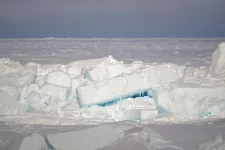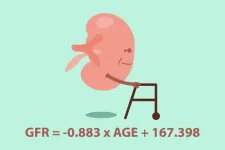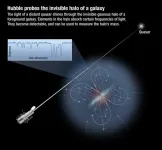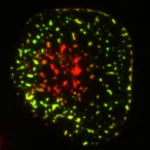(Press-News.org) In the Arctic, the old, multiyear ice is increasingly melting, dramatically reducing the frequency and size of pressure ridges. These ridges are created when ice floes press against each other and become stacked, and are a characteristic feature of Arctic sea ice, an obstacle for shipping, but also an essential component of the ecosystem. In a recently released study in the journal Nature Climate Change, experts from the Alfred Wegener Institute report on this trend and analyse observational data from three decades of aerial surveys.
Satellite data from the last three decades documents the dramatic changes in Arctic sea ice due to climate change: the area covered in ice in summer is declining steadily, the floes are becoming thinner and moving faster. Until recently, it was unclear how the characteristic pressure ridges had been affected, since it’s only been possible to reliably monitor them from space for the past few years.
Pressure ridges are produced by lateral pressures on sea ice. Wind or ocean currents can stack floes up, forming metre-thick ridges. The part of the ridges – which break up the otherwise smooth surface of the ice every few hundred metres – extending above the water is called the sail and measures between one and two metres. Even more impressive is the keel below the water line, which can extend down to 30 metres and create an impassable obstacle for shipping. Pressure ridges affect not only the energy and mass balance of the sea ice, but also the biogeochemical cycle and the ecosystem: when their sails catch the wind, floes can be driven all across the Arctic. Polar bears use pressure ridges as a source of protection for overwintering or birthing their young. In addition, the structures offer ice-associated organisms at various trophic levels protection and promote the turbulent mixing of water, which increases nutrient availability.
A team of researchers from the Alfred Wegener Institute, Helmholtz Centre for Polar and Marine Research (AWI), has now reprocessed and analysed laser-based readings gathered in 30 years of research flights over the Arctic ice. The survey flights, which cover a total distance of roughly 76,000 kilometres, show for the first time that the frequency of pressure ridges north of Greenland and in Fram Strait is decreasing by 12.2%, and their height by 5%, per decade. Data from the Lincoln Sea, an area where particularly old ice is known to accumulate, paints a similar picture: here, the frequency is declining by 14.9% and the height by 10.4% per decade.
“Until now, it’s remained unclear how pressure ridges were changing,” says Dr Thomas Krumpen, a sea-ice expert at the AWI and the study’s main author. “More and more of the Arctic consists of ice that melts in the summer and is no more than a year old. This young, thin ice can more readily be deformed and more rapidly forms new pressure ridges. So you might expect their frequency to increase. The fact that pressure ridges are nonetheless in decline is due to the dramatic melting of older floes. Ice that has survived several summers is characterised by a particularly high number of pressure ridges, since it has been subjected to high pressures over a longer timeframe. The loss of this multiyear ice is so severe that we’re observing an overall decline in pressure-ridge frequency, even though the thin young ice is easier to deform.”
In order to draw conclusions regarding Arctic-wide changes, the researchers combined all observational data to develop a metric. Then, with the aid of satellite data, they applied it to the Arctic as a whole: “We tend to see the greatest decline in pressure ridges in those places where the ice’s age has decreased most,” summarises Prof Christian Haas, Head of Sea-ice Physics at the AWI. “Major changes can be seen in the Beaufort Sea, but also in the Central Arctic. Both regions are now partly ice-free in summer, though they were once dominated by ice that was at least five years old.”
For the study, individual pressure ridges and their heights were precisely measured and analysed during survey flights. This was possible thanks to the low-level flights (less than 100 metres above the surface) and the laser sensors’ high scanning rate, which allowed terrain models to be created. The AWI began scientific flights over the sea ice in the early 1990s, launching from Svalbard. Back then, the institute relied on two Dornier DO228s, Polar 2 and Polar 4; they have since been succeeded by two Basler BT-67s, Polar 5 and Polar 6. Specially equipped for flights under the extreme conditions found in the polar regions, they can be fitted with a range of sensors. Using these aircraft, researchers survey the ice north of Greenland, Svalbard and Canada twice a year. But the icebreaker Polarstern’s onboard helicopters are also part of the monitoring programme.
In order to estimate the direct effects of the observed changes on the Arctic ecosystem, models need to be developed that can reflect both physical and biological processes in sea ice of various ages. Although we know that pressure ridges are home to a range of organisms, we still lack a deeper understanding of the role of pressure-ridge age. Yet this aspect is especially important, as the percentage of ridges that don’t survive their first summer is on the rise. Another riddle: although the size and frequency of ridge sails have decreased, the drift speed of Arctic ice has generally increased. As AWI sea-ice physicist Dr Luisa von Albedyll, who contributed to the study, explains: “Actually, the ice should drift more slowly when the sails shrink, since there’s less area for the transfer of momentum. This indicates that there are other changes producing just the opposite effect. Stronger ocean currents or a smoother ice underside due to more intensive melting could be contributing factors. To answer these open questions and gain a better grasp of the complex interrelationships, we have made the entire dataset available in a public archive, (Link zu PANGAEA), ensuring that other researchers can use it and integrate it into their studies.”
An expedition with the research vessel Polarstern is planned for next summer, with a focus on investigating the biological and biogeochemical differences between floes and pressure ridges of different ages and provenances. At the same time, there will be extensive aerial survey flights with the research aircraft. According to Thomas Krumpen: “By combining ship-based and aerial observations, we hope to gain better insights into the complex interactions between the sea ice, climate and ecosystem – since we’ll only be able to devise effective strategies for the preservation and sustainable use of the Arctic once we better understand the region’s environmental system.”
END
Marked decrease in Arctic pressure ridges
Analysis of three decades of aerial survey data reveals major changes
2025-01-06
ELSE PRESS RELEASES FROM THIS DATE:
Age matters: Kidney disorder indicator gains precision
2025-01-06
Annual health checkups regularly include urine tests that serve several purposes, including checking for symptoms of kidney disease. The presence of albumin in the urine is one indicator as is glomerular filtration rate. In diabetic nephropathy, albuminuria first appears, leading to excessive filtration and eventually a decrease in GFR.
In the elderly, however, excessive filtration cannot be detected due to age-related GFR decline. To accurately assess GFR, Osaka Metropolitan University researchers have come up with ...
New guidelines for managing blood cancers in pregnancy
2025-01-04
A new set of guidelines has been developed to assist with the diagnosis and expert management of serious blood cancers in pregnancy.
About 12.5 pregnancies per 100,000 are affected by blood cancers such as acute leukaemia and aggressive lymphomas, and their incidence has been rising.
Between 1994 and 2013, they increased by 2.7 per cent a year, due to factors including women having children later, improved diagnostic techniques, and increased health system engagement.
An Australian working group has now published a new position statement in the latest edition of The Lancet Haematology, based on current evidence and expert consensus.
It ...
New study suggests RNA present on surfaces of leaves may shape microbial communities
2025-01-03
Biologists at Indiana University Bloomington have shown that the surfaces of plant leaves are coated with a diverse array of RNA molecules. The finding suggests that the RNA present on the leaf surface may play a role in shaping the microbial communities that inhabit them, potentially influencing plant health and interactions within their environment, according to a new study.
The study, Diverse plant RNAs coat Arabidopsis leaves and are distinct from apoplastic RNAs, was published Jan. 3, 2025 in the Proceedings of the National Academy of Sciences. The first authors are Lucía ...
U.S. suffers from low social mobility. Is sprawl partly to blame?
2025-01-03
Urban sprawl is not just unsightly. It could also be impeding intergenerational mobility for low-income residents and reinforcing racial inequality, according to a series of recent studies led by a University of Utah geographer.
One analysis of tract-level Census data co-authored with a former economics graduate student in the U’s College of Social & Behavioral Science found that people who grew up in high-sprawl neighborhoods have less earning potential than those who grew in denser neighborhoods.
“For adults, jobs are harder to access in more sprawling neighborhoods,” said Kelsey Carlston, now an assistant professor of economics at Gonzaga University. “If we ...
Research spotlight: Improving predictions about brain cancer outcomes with the right imaging criteria
2025-01-03
Raymond Y. Huang, MD, Ph.D., of the Department of Radiology at Brigham and Women’s Hospital, is the corresponding author of a paper published in the Journal of Clinical Oncology, “Comparative Analysis of Intracranial Response Assessment Criteria in Patients With Melanoma Brain Metastases Treated With Combination Nivolumab + Ipilimumab in CheckMate 204.”
How would you summarize your study for a lay audience?
Our study examines how different imaging criteria can be used to assess brain tumor responses ...
New UVA professor’s research may boost next-generation space rockets
2025-01-03
Go faster, farther, more efficiently.
That’s the goal driving spacecraft propulsion engineers like Chen Cui, a new assistant professor at the University of Virginia School of Engineering and Applied Science. Cui is exploring ways to improve electric propulsion thrusters — a key technology for future space missions.
“In order to ensure the technology remains viable for long-term missions, we need to optimize EP integration with spacecraft systems,” Cui said.
Working with his former adviser, University of Southern California professor Joseph Wang, ...
Multilingualism improves crucial cognitive functions in autistic children
2025-01-03
A new study from UCLA Health adds to the growing body of evidence on the cognitive benefits of speaking multiple languages, finding that multilingualism not only enhances general cognitive abilities but also may help reduce certain symptoms and bolster control of daily thoughts and actions in children with and without autism.
The study, published in the journal Autism Research, found parents of autistic and non-autistic children in multilingual households reported their children had stronger overall executive ...
The carbon in our bodies probably left the galaxy and came back on cosmic ‘conveyer belt’
2025-01-03
Link to full release:
https://www.washington.edu/news/2025/01/03/galaxy-carbon-conveyer-belt/
FROM: James Urton
University of Washington
206-543-2580
jurton@uw.edu
(Note: researcher contact information at the end)
For immediate release
Friday, Jan. 3, 2025
The carbon in our bodies probably left the galaxy and came back on cosmic ‘conveyer belt’
Life on Earth could not exist without carbon. But carbon itself could not exist without stars. Nearly all elements except hydrogen and ...
Scientists unveil surprising human vs mouse differences in a major cancer immunotherapy target
2025-01-03
Since its discovery in the 1990s, “programmed cell death protein 1,” or PD-1, has been regarded as a leading target in cancer treatments. A “checkpoint” receptor that often resides on the surface of immune system cells, the PD-1 molecule works as a type of off switch that keeps immune cells from attacking other cells.
After its discovery, which revolutionized oncology and earned a 2018 Nobel Prize, researchers developed new drugs to block PD-1 and unleash the body’s immune system to fight cancer. Yet treatments leveraging PD-1 are only effective in a small fraction of cancer patients, highlighting ...
NASA’s LEXI will provide X-ray vision of Earth’s magnetosphere
2025-01-03
A NASA X-ray imager is heading to the Moon as part of NASA's Artemis campaign, where it will capture the first global images of the magnetic field that shields Earth from solar radiation.
The Lunar Environment Heliospheric X-ray Imager, or LEXI, instrument is one of 10 payloads aboard the next lunar delivery through NASA’s CLPS (Commercial Lunar Payload Services) initiative, set to launch from the agency's Kennedy Space Center in Florida no earlier than mid-January, with Firefly Aerospace’s Blue Ghost Lander. The instrument will support ...
LAST 30 PRESS RELEASES:
House sparrows in northern Norway can help us save other endangered animals
Crohn's & Colitis Foundation survey reveals more than 1/3 of young adults with IBD face step therapy insurance barriers
Tethered UAV autonomous knotting on environmental structures for transport
Decentralized social media platforms unlock authentic consumer feedback
American Pediatric Society announces Vanderbilt University School of Medicine as host institution for APS Howland Visiting Professor Program
Scientists discover first method to safely back up quantum information
A role for orange pigments in birds and human redheads
Pathways to net-zero greenhouse gas emissions for Southeast Asia
A JBNU–KIMS collaborative study on a cost-effective alloy matches superalloys for power plants and energy infrastructure
New study overturns long-held model of how plants coordinate immune responses.
New AI model predicts disease risk while you sleep
Scientists discover molecular ‘reshuffle’ and crack an 80-year-old conundrum
How stressors during pregnancy impact the developing fetal brain
Electrons lag behind the nucleus
From fungi to brain cells: one scientist's winding path reveals how epigenomics shapes neural destiny
Schizophrenia and osteoporosis share 195 genetic loci, highlighting unexpected biological bridges between brain and bone
Schizophrenia-linked genetic variant renders key brain receptor completely unresponsive to both natural and therapeutic compounds
Innovative review reveals overlooked complexity in cellular energy sensor's dual roles in Alzheimer's disease
Autism research reframed: Why heterogeneity is the data, not the noise
Brazil's genetic treasure trove: supercentenarians reveal secrets of extreme human longevity
The (metabolic) cost of life
CFRI special issue call for papers: New Frontiers in Sustainable Finance
HKU Engineering scholar demonstrates the smallest all-printed infrared photodetectors to date
Precision empowerment for brain "eavesdropping": CAS team develops triple-electrode integrated functional electrode for simultaneous monitoring of neural signals and chemical transmitters during sleep
Single-capillary endothelial dysfunction resolved by optoacoustic mesoscopy
HKU three research projects named among ‘Top 10 Innovation & Technology News in Hong Kong 2025’ showcasing excellence in research and technology transfer
NLRSeek: A reannotation-based pipeline for mining missing NLR genes in sequenced genomes
A strand and whole genome duplication–aware collinear gene identification tool
Light storage in light cages: A revolutionary approach to on-chip quantum memories
Point spread function decoupling in computational fluorescence microscopy
[Press-News.org] Marked decrease in Arctic pressure ridgesAnalysis of three decades of aerial survey data reveals major changes





